What does cognitive behavioral therapy do?
VerifiedAdded on 2022/08/12
|8
|1346
|21
AI Summary
Contribute Materials
Your contribution can guide someone’s learning journey. Share your
documents today.
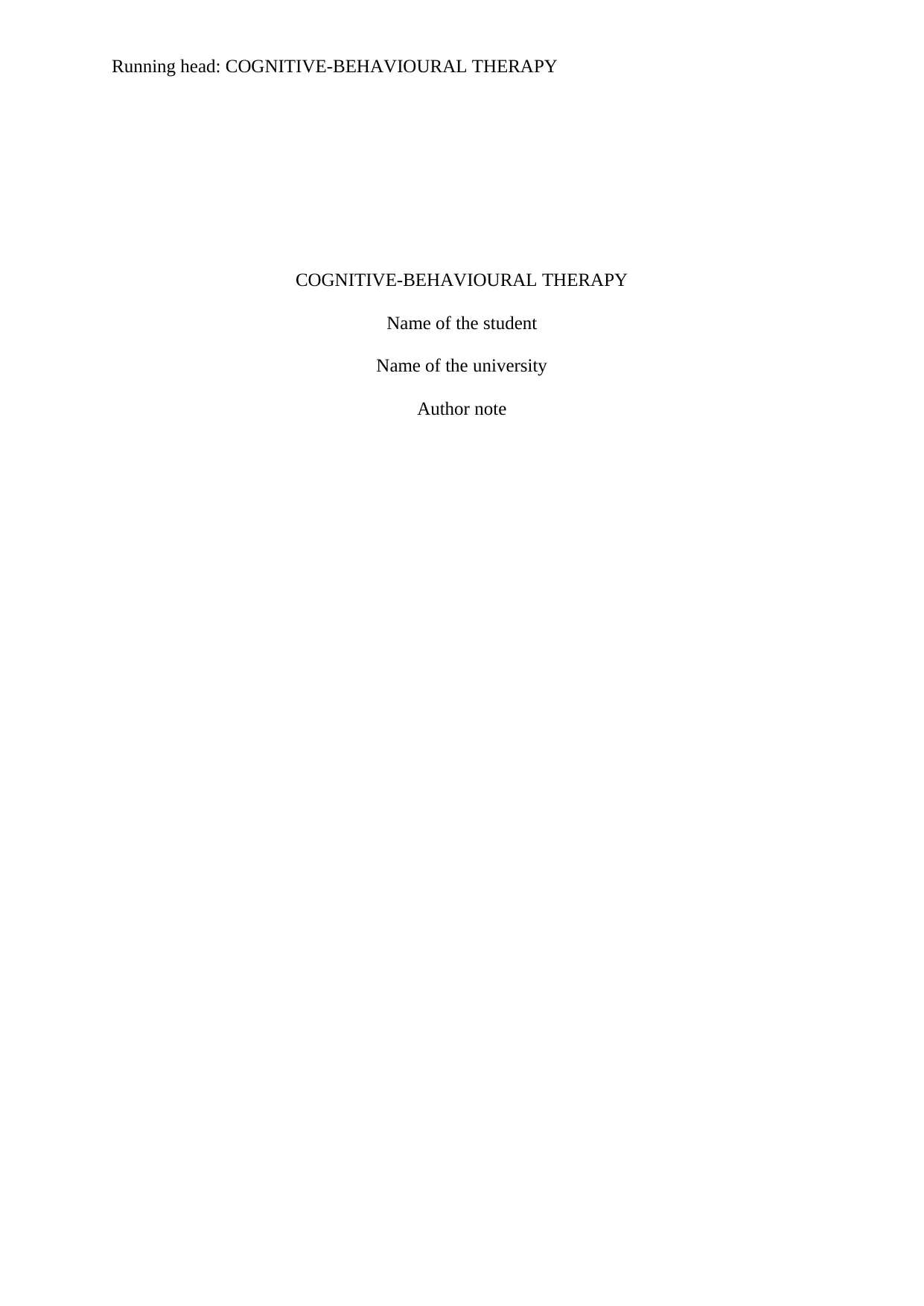
Running head: COGNITIVE-BEHAVIOURAL THERAPY
COGNITIVE-BEHAVIOURAL THERAPY
Name of the student
Name of the university
Author note
COGNITIVE-BEHAVIOURAL THERAPY
Name of the student
Name of the university
Author note
Secure Best Marks with AI Grader
Need help grading? Try our AI Grader for instant feedback on your assignments.
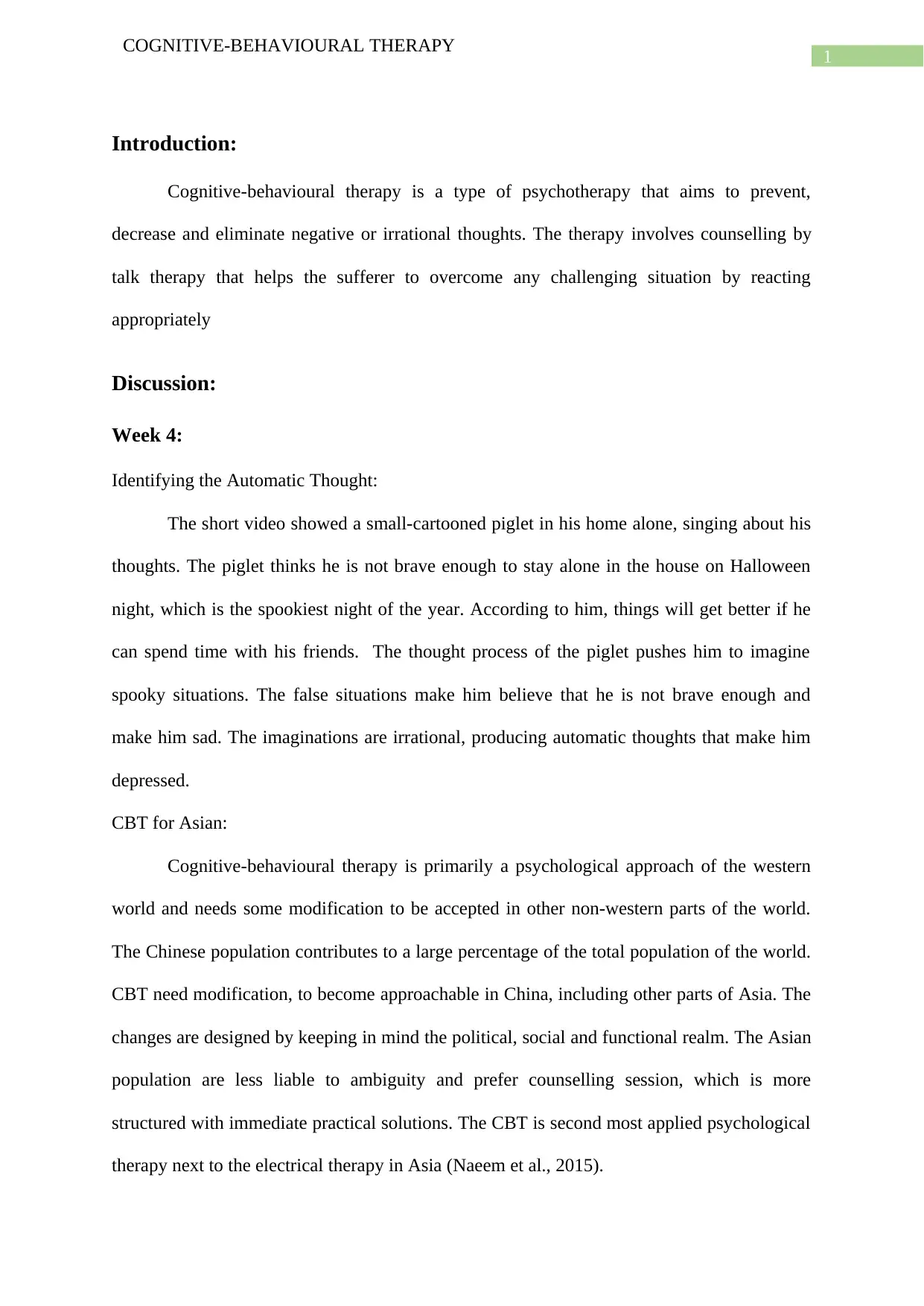
1
COGNITIVE-BEHAVIOURAL THERAPY
Introduction:
Cognitive-behavioural therapy is a type of psychotherapy that aims to prevent,
decrease and eliminate negative or irrational thoughts. The therapy involves counselling by
talk therapy that helps the sufferer to overcome any challenging situation by reacting
appropriately
Discussion:
Week 4:
Identifying the Automatic Thought:
The short video showed a small-cartooned piglet in his home alone, singing about his
thoughts. The piglet thinks he is not brave enough to stay alone in the house on Halloween
night, which is the spookiest night of the year. According to him, things will get better if he
can spend time with his friends. The thought process of the piglet pushes him to imagine
spooky situations. The false situations make him believe that he is not brave enough and
make him sad. The imaginations are irrational, producing automatic thoughts that make him
depressed.
CBT for Asian:
Cognitive-behavioural therapy is primarily a psychological approach of the western
world and needs some modification to be accepted in other non-western parts of the world.
The Chinese population contributes to a large percentage of the total population of the world.
CBT need modification, to become approachable in China, including other parts of Asia. The
changes are designed by keeping in mind the political, social and functional realm. The Asian
population are less liable to ambiguity and prefer counselling session, which is more
structured with immediate practical solutions. The CBT is second most applied psychological
therapy next to the electrical therapy in Asia (Naeem et al., 2015).
COGNITIVE-BEHAVIOURAL THERAPY
Introduction:
Cognitive-behavioural therapy is a type of psychotherapy that aims to prevent,
decrease and eliminate negative or irrational thoughts. The therapy involves counselling by
talk therapy that helps the sufferer to overcome any challenging situation by reacting
appropriately
Discussion:
Week 4:
Identifying the Automatic Thought:
The short video showed a small-cartooned piglet in his home alone, singing about his
thoughts. The piglet thinks he is not brave enough to stay alone in the house on Halloween
night, which is the spookiest night of the year. According to him, things will get better if he
can spend time with his friends. The thought process of the piglet pushes him to imagine
spooky situations. The false situations make him believe that he is not brave enough and
make him sad. The imaginations are irrational, producing automatic thoughts that make him
depressed.
CBT for Asian:
Cognitive-behavioural therapy is primarily a psychological approach of the western
world and needs some modification to be accepted in other non-western parts of the world.
The Chinese population contributes to a large percentage of the total population of the world.
CBT need modification, to become approachable in China, including other parts of Asia. The
changes are designed by keeping in mind the political, social and functional realm. The Asian
population are less liable to ambiguity and prefer counselling session, which is more
structured with immediate practical solutions. The CBT is second most applied psychological
therapy next to the electrical therapy in Asia (Naeem et al., 2015).

2
COGNITIVE-BEHAVIOURAL THERAPY
COGNITIVE-BEHAVIOURAL THERAPY
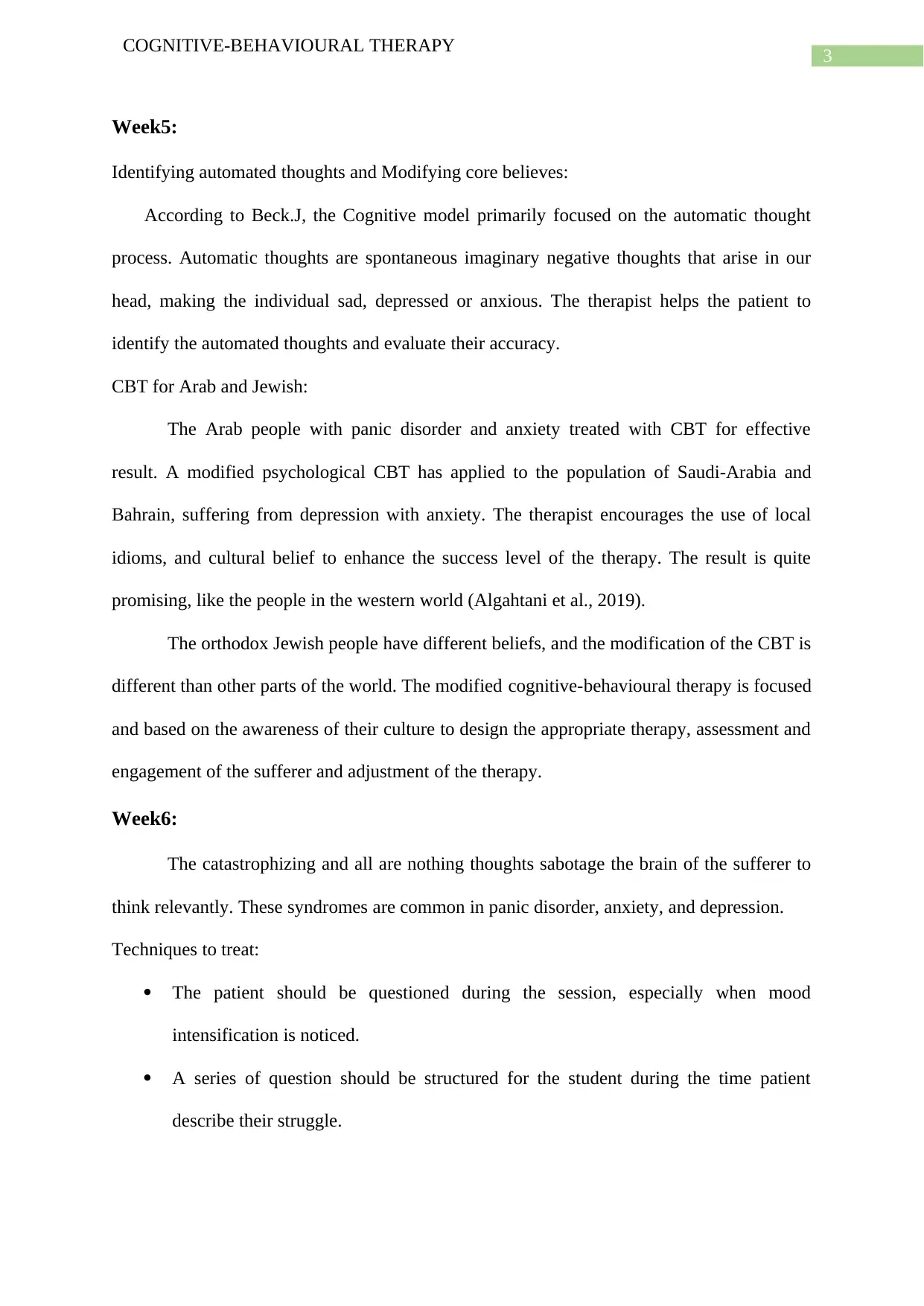
3
COGNITIVE-BEHAVIOURAL THERAPY
Week5:
Identifying automated thoughts and Modifying core believes:
According to Beck.J, the Cognitive model primarily focused on the automatic thought
process. Automatic thoughts are spontaneous imaginary negative thoughts that arise in our
head, making the individual sad, depressed or anxious. The therapist helps the patient to
identify the automated thoughts and evaluate their accuracy.
CBT for Arab and Jewish:
The Arab people with panic disorder and anxiety treated with CBT for effective
result. A modified psychological CBT has applied to the population of Saudi-Arabia and
Bahrain, suffering from depression with anxiety. The therapist encourages the use of local
idioms, and cultural belief to enhance the success level of the therapy. The result is quite
promising, like the people in the western world (Algahtani et al., 2019).
The orthodox Jewish people have different beliefs, and the modification of the CBT is
different than other parts of the world. The modified cognitive-behavioural therapy is focused
and based on the awareness of their culture to design the appropriate therapy, assessment and
engagement of the sufferer and adjustment of the therapy.
Week6:
The catastrophizing and all are nothing thoughts sabotage the brain of the sufferer to
think relevantly. These syndromes are common in panic disorder, anxiety, and depression.
Techniques to treat:
The patient should be questioned during the session, especially when mood
intensification is noticed.
A series of question should be structured for the student during the time patient
describe their struggle.
COGNITIVE-BEHAVIOURAL THERAPY
Week5:
Identifying automated thoughts and Modifying core believes:
According to Beck.J, the Cognitive model primarily focused on the automatic thought
process. Automatic thoughts are spontaneous imaginary negative thoughts that arise in our
head, making the individual sad, depressed or anxious. The therapist helps the patient to
identify the automated thoughts and evaluate their accuracy.
CBT for Arab and Jewish:
The Arab people with panic disorder and anxiety treated with CBT for effective
result. A modified psychological CBT has applied to the population of Saudi-Arabia and
Bahrain, suffering from depression with anxiety. The therapist encourages the use of local
idioms, and cultural belief to enhance the success level of the therapy. The result is quite
promising, like the people in the western world (Algahtani et al., 2019).
The orthodox Jewish people have different beliefs, and the modification of the CBT is
different than other parts of the world. The modified cognitive-behavioural therapy is focused
and based on the awareness of their culture to design the appropriate therapy, assessment and
engagement of the sufferer and adjustment of the therapy.
Week6:
The catastrophizing and all are nothing thoughts sabotage the brain of the sufferer to
think relevantly. These syndromes are common in panic disorder, anxiety, and depression.
Techniques to treat:
The patient should be questioned during the session, especially when mood
intensification is noticed.
A series of question should be structured for the student during the time patient
describe their struggle.
Secure Best Marks with AI Grader
Need help grading? Try our AI Grader for instant feedback on your assignments.
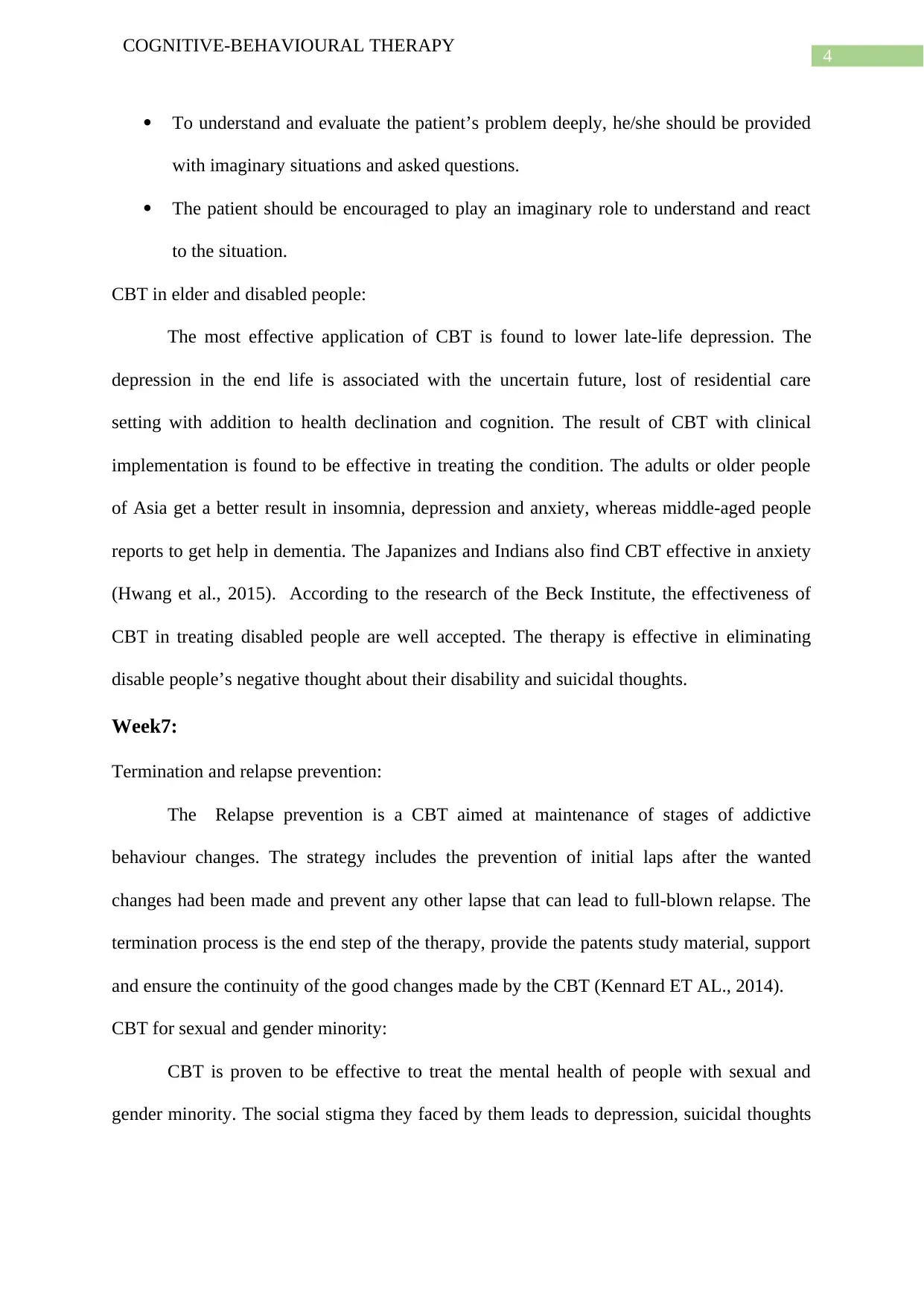
4
COGNITIVE-BEHAVIOURAL THERAPY
To understand and evaluate the patient’s problem deeply, he/she should be provided
with imaginary situations and asked questions.
The patient should be encouraged to play an imaginary role to understand and react
to the situation.
CBT in elder and disabled people:
The most effective application of CBT is found to lower late-life depression. The
depression in the end life is associated with the uncertain future, lost of residential care
setting with addition to health declination and cognition. The result of CBT with clinical
implementation is found to be effective in treating the condition. The adults or older people
of Asia get a better result in insomnia, depression and anxiety, whereas middle-aged people
reports to get help in dementia. The Japanizes and Indians also find CBT effective in anxiety
(Hwang et al., 2015). According to the research of the Beck Institute, the effectiveness of
CBT in treating disabled people are well accepted. The therapy is effective in eliminating
disable people’s negative thought about their disability and suicidal thoughts.
Week7:
Termination and relapse prevention:
The Relapse prevention is a CBT aimed at maintenance of stages of addictive
behaviour changes. The strategy includes the prevention of initial laps after the wanted
changes had been made and prevent any other lapse that can lead to full-blown relapse. The
termination process is the end step of the therapy, provide the patents study material, support
and ensure the continuity of the good changes made by the CBT (Kennard ET AL., 2014).
CBT for sexual and gender minority:
CBT is proven to be effective to treat the mental health of people with sexual and
gender minority. The social stigma they faced by them leads to depression, suicidal thoughts
COGNITIVE-BEHAVIOURAL THERAPY
To understand and evaluate the patient’s problem deeply, he/she should be provided
with imaginary situations and asked questions.
The patient should be encouraged to play an imaginary role to understand and react
to the situation.
CBT in elder and disabled people:
The most effective application of CBT is found to lower late-life depression. The
depression in the end life is associated with the uncertain future, lost of residential care
setting with addition to health declination and cognition. The result of CBT with clinical
implementation is found to be effective in treating the condition. The adults or older people
of Asia get a better result in insomnia, depression and anxiety, whereas middle-aged people
reports to get help in dementia. The Japanizes and Indians also find CBT effective in anxiety
(Hwang et al., 2015). According to the research of the Beck Institute, the effectiveness of
CBT in treating disabled people are well accepted. The therapy is effective in eliminating
disable people’s negative thought about their disability and suicidal thoughts.
Week7:
Termination and relapse prevention:
The Relapse prevention is a CBT aimed at maintenance of stages of addictive
behaviour changes. The strategy includes the prevention of initial laps after the wanted
changes had been made and prevent any other lapse that can lead to full-blown relapse. The
termination process is the end step of the therapy, provide the patents study material, support
and ensure the continuity of the good changes made by the CBT (Kennard ET AL., 2014).
CBT for sexual and gender minority:
CBT is proven to be effective to treat the mental health of people with sexual and
gender minority. The social stigma they faced by them leads to depression, suicidal thoughts

5
COGNITIVE-BEHAVIOURAL THERAPY
and anxiety. The application of affirmative-cogitative behavioral therapy can improve this
condition (Craig & Austin, 2016).
COGNITIVE-BEHAVIOURAL THERAPY
and anxiety. The application of affirmative-cogitative behavioral therapy can improve this
condition (Craig & Austin, 2016).
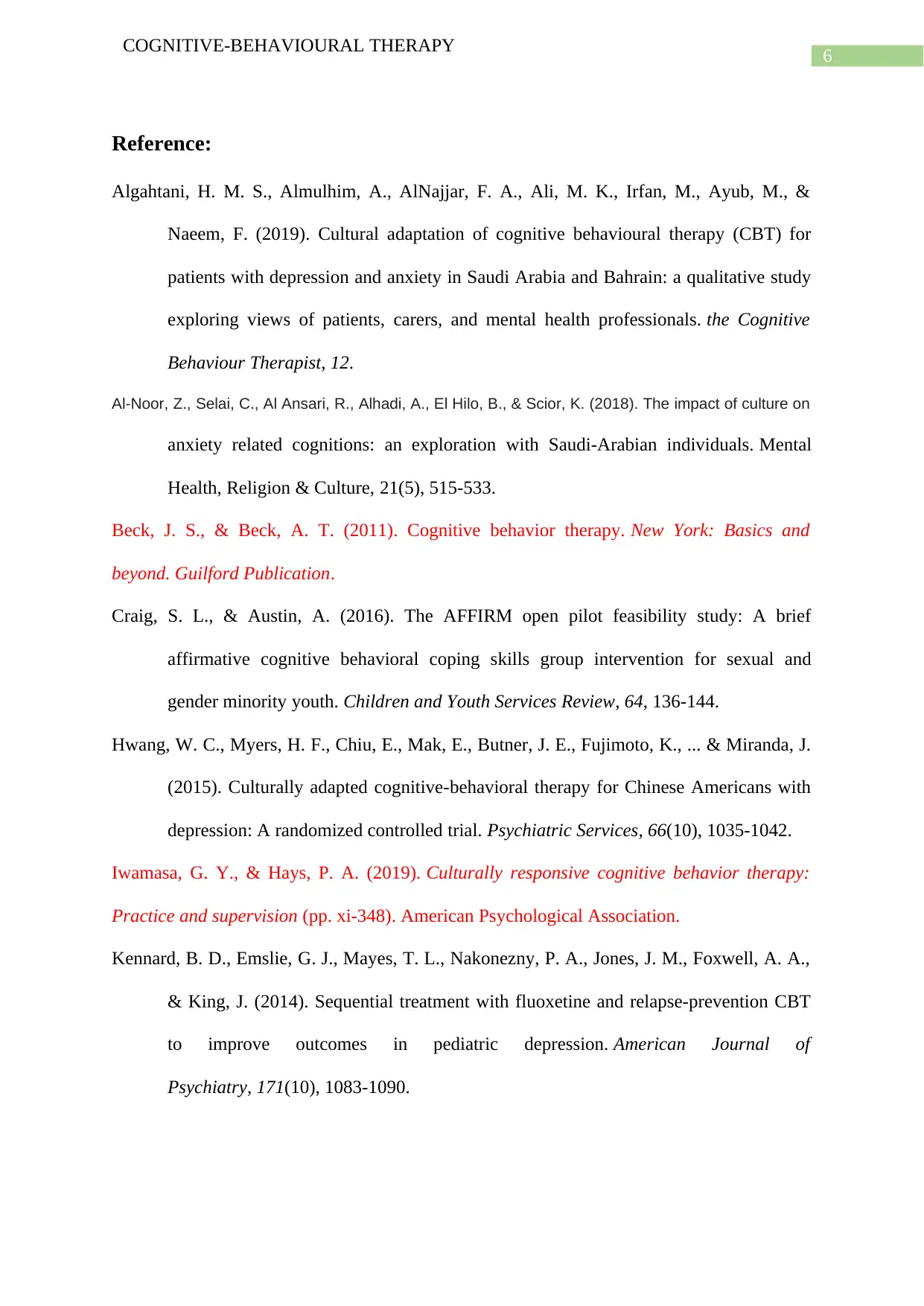
6
COGNITIVE-BEHAVIOURAL THERAPY
Reference:
Algahtani, H. M. S., Almulhim, A., AlNajjar, F. A., Ali, M. K., Irfan, M., Ayub, M., &
Naeem, F. (2019). Cultural adaptation of cognitive behavioural therapy (CBT) for
patients with depression and anxiety in Saudi Arabia and Bahrain: a qualitative study
exploring views of patients, carers, and mental health professionals. the Cognitive
Behaviour Therapist, 12.
Al-Noor, Z., Selai, C., Al Ansari, R., Alhadi, A., El Hilo, B., & Scior, K. (2018). The impact of culture on
anxiety related cognitions: an exploration with Saudi-Arabian individuals. Mental
Health, Religion & Culture, 21(5), 515-533.
Beck, J. S., & Beck, A. T. (2011). Cognitive behavior therapy. New York: Basics and
beyond. Guilford Publication.
Craig, S. L., & Austin, A. (2016). The AFFIRM open pilot feasibility study: A brief
affirmative cognitive behavioral coping skills group intervention for sexual and
gender minority youth. Children and Youth Services Review, 64, 136-144.
Hwang, W. C., Myers, H. F., Chiu, E., Mak, E., Butner, J. E., Fujimoto, K., ... & Miranda, J.
(2015). Culturally adapted cognitive-behavioral therapy for Chinese Americans with
depression: A randomized controlled trial. Psychiatric Services, 66(10), 1035-1042.
Iwamasa, G. Y., & Hays, P. A. (2019). Culturally responsive cognitive behavior therapy:
Practice and supervision (pp. xi-348). American Psychological Association.
Kennard, B. D., Emslie, G. J., Mayes, T. L., Nakonezny, P. A., Jones, J. M., Foxwell, A. A.,
& King, J. (2014). Sequential treatment with fluoxetine and relapse-prevention CBT
to improve outcomes in pediatric depression. American Journal of
Psychiatry, 171(10), 1083-1090.
COGNITIVE-BEHAVIOURAL THERAPY
Reference:
Algahtani, H. M. S., Almulhim, A., AlNajjar, F. A., Ali, M. K., Irfan, M., Ayub, M., &
Naeem, F. (2019). Cultural adaptation of cognitive behavioural therapy (CBT) for
patients with depression and anxiety in Saudi Arabia and Bahrain: a qualitative study
exploring views of patients, carers, and mental health professionals. the Cognitive
Behaviour Therapist, 12.
Al-Noor, Z., Selai, C., Al Ansari, R., Alhadi, A., El Hilo, B., & Scior, K. (2018). The impact of culture on
anxiety related cognitions: an exploration with Saudi-Arabian individuals. Mental
Health, Religion & Culture, 21(5), 515-533.
Beck, J. S., & Beck, A. T. (2011). Cognitive behavior therapy. New York: Basics and
beyond. Guilford Publication.
Craig, S. L., & Austin, A. (2016). The AFFIRM open pilot feasibility study: A brief
affirmative cognitive behavioral coping skills group intervention for sexual and
gender minority youth. Children and Youth Services Review, 64, 136-144.
Hwang, W. C., Myers, H. F., Chiu, E., Mak, E., Butner, J. E., Fujimoto, K., ... & Miranda, J.
(2015). Culturally adapted cognitive-behavioral therapy for Chinese Americans with
depression: A randomized controlled trial. Psychiatric Services, 66(10), 1035-1042.
Iwamasa, G. Y., & Hays, P. A. (2019). Culturally responsive cognitive behavior therapy:
Practice and supervision (pp. xi-348). American Psychological Association.
Kennard, B. D., Emslie, G. J., Mayes, T. L., Nakonezny, P. A., Jones, J. M., Foxwell, A. A.,
& King, J. (2014). Sequential treatment with fluoxetine and relapse-prevention CBT
to improve outcomes in pediatric depression. American Journal of
Psychiatry, 171(10), 1083-1090.
Paraphrase This Document
Need a fresh take? Get an instant paraphrase of this document with our AI Paraphraser
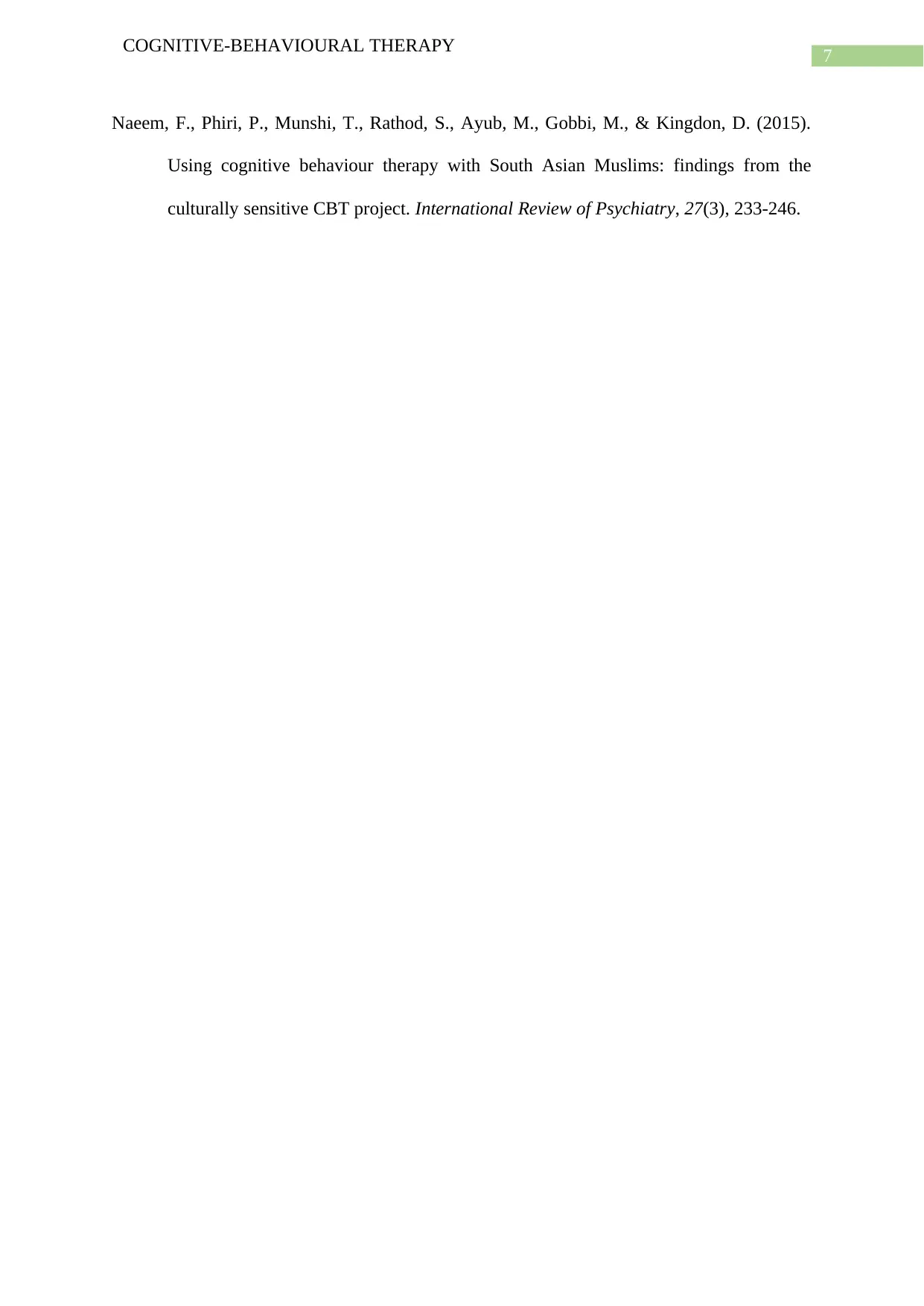
7
COGNITIVE-BEHAVIOURAL THERAPY
Naeem, F., Phiri, P., Munshi, T., Rathod, S., Ayub, M., Gobbi, M., & Kingdon, D. (2015).
Using cognitive behaviour therapy with South Asian Muslims: findings from the
culturally sensitive CBT project. International Review of Psychiatry, 27(3), 233-246.
COGNITIVE-BEHAVIOURAL THERAPY
Naeem, F., Phiri, P., Munshi, T., Rathod, S., Ayub, M., Gobbi, M., & Kingdon, D. (2015).
Using cognitive behaviour therapy with South Asian Muslims: findings from the
culturally sensitive CBT project. International Review of Psychiatry, 27(3), 233-246.
1 out of 8
Related Documents
Your All-in-One AI-Powered Toolkit for Academic Success.
+13062052269
info@desklib.com
Available 24*7 on WhatsApp / Email
![[object Object]](/_next/static/media/star-bottom.7253800d.svg)
Unlock your academic potential
© 2024 | Zucol Services PVT LTD | All rights reserved.




